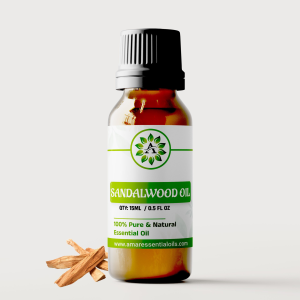Indian Sandalwood Oil
What is Indian Sandalwood Oil?
Indian sandalwood oil, extracted from the heartwood of the Santalum album tree, is one of the most treasured essential oils in the world. Known for its rich, woody, and creamy aroma, this oil has been a staple in Ayurvedic medicine, perfumery, and spiritual rituals for centuries. Its fragrance isn’t just pleasing—it’s profoundly therapeutic. From reducing stress and anxiety to healing the skin and balancing energy, this oil is a powerhouse in a tiny bottle.
Often mistaken for other types of sandalwood oils like Australian or Hawaiian, Indian sandalwood oil stands out due to its superior quality and higher alpha-santalol content (around 90%), which is responsible for most of its therapeutic effects. This makes it a premium product and also a rare one, as the Santalum album tree takes decades to mature and produce oil.
Historical and Cultural Value
Indian sandalwood oil’s legacy is deeply rooted in Indian heritage. It has been mentioned in Vedic texts dating back over 4,000 years and has played an integral role in religious and spiritual ceremonies. Temples were constructed from sandalwood, and the oil was used to anoint gods and cleanse spiritual spaces. Indian royals used it in their skincare and fragrance routines, symbolizing purity, status, and sanctity.
Even today, it remains a crucial part of Hindu rituals, Buddhist meditation, and even Islamic practices. The oil is seen as a bridge between the physical and spiritual, grounding the soul and inviting peace.
2. Botanical Profile of Santalum Album
Origin and Cultivation
Santalum album, the tree from which Indian sandalwood oil is extracted, is native to the Indian subcontinent. It thrives in the southern regions, especially Karnataka, Tamil Nadu, and Andhra Pradesh. The tree is semi-parasitic, meaning it relies on host trees for certain nutrients, making its cultivation a bit more complex.
It typically takes 15–20 years for a tree to yield oil-rich heartwood. Due to overharvesting and illegal logging, the Indian government has put strict regulations on its harvesting and trade. This has both protected the species and driven up its value in the global market.
Buy 100% Pure & Natural Sandalwood Oil
Differences Between Indian and Other Types of Sandalwood
There’s a lot of confusion between Indian sandalwood (Santalum album) and its other varieties like Australian sandalwood (Santalum spicatum) or Hawaiian sandalwood (Santalum paniculatum). Here’s what sets Indian sandalwood apart:
- Higher alpha-santalol content (around 90% vs. 25–30% in Australian)
- Sweeter, richer aroma—warmer and creamier
- More potent therapeutic effects
Because of these qualities, Indian sandalwood oil is far more expensive and often the preferred choice for high-end perfumery, luxury skincare, and spiritual use.
3. How Indian Sandalwood Oil is Extracted
Traditional Steam Distillation Process
The most common method of extracting Indian sandalwood oil is steam distillation. The heartwood of the tree is first chipped and powdered. These wood chips are then steamed, and the vapors are condensed into oil and hydrosol. It’s a labor-intensive and time-consuming process, often taking several days to extract just a small amount of pure oil.
The longer the distillation, the better the yield and potency. No solvents or chemical additives are used, making it a completely natural process. The result is a golden to pale yellow oil with a thick consistency and a divine aroma.
Ethical and Sustainable Harvesting Practices
Because of its protected status, Indian sandalwood must be harvested with government approval. Many reputable companies now work with sustainable farms and agroforestry initiatives that cultivate Santalum album trees without harming the ecosystem.
Ethical sourcing involves:
- Harvesting only mature trees
- Replanting programs for future generations
- Full traceability of the oil’s origin
This helps preserve the species and supports local farming communities.

4. Therapeutic Properties of Indian Sandalwood Oil
Anti-inflammatory and Antimicrobial Effects
One of the most impressive features of Indian sandalwood oil is its ability to heal. Thanks to its high alpha-santalol content, it possesses strong anti-inflammatory and antimicrobial properties. It soothes skin irritation, reduces redness, and can even combat bacteria responsible for acne and infections.
Many modern dermatological products now incorporate sandalwood oil for this reason. It’s also helpful for easing respiratory issues, reducing fever, and healing wounds, cuts, and bites.
Emotional and Mental Wellness
Indian sandalwood oil is often called “liquid meditation.” Just inhaling its scent can calm an overactive mind and reduce symptoms of anxiety and depression. It’s used widely in aromatherapy for relaxation, emotional balance, and mental clarity.
Here’s how it helps:
- Promotes better sleep by calming the nervous system
- Reduces cortisol levels (the stress hormone)
- Enhances focus and concentration during meditation
Its grounding and stabilizing nature makes it a favorite among healers, yogis, and therapists.
5. Skin and Beauty Benefits of Indian Sandalwood Oil
Natural Remedy for Acne and Scars
Indian sandalwood oil is a natural antiseptic and astringent, which makes it incredibly effective in managing acne and blemishes. When diluted with a carrier oil like jojoba or almond oil, it can:
- Reduce acne-causing bacteria
- Minimize pores
- Lighten acne scars and dark spots
It works gently, without drying or irritating the skin like harsh chemical-based products.
Anti-aging and Skin Brightening Properties
With regular use, Indian sandalwood oil can enhance your skin’s appearance by:
- Boosting cell regeneration
- Reducing fine lines and wrinkles
- Improving overall skin tone and texture
